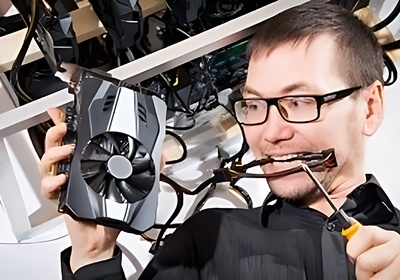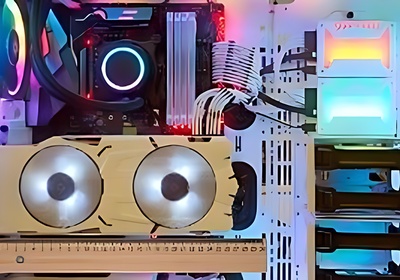Installing or changing the graphics card - this is what you should know

The game lags, the video also keeps freezing - you are annoyed. The computer is a few years old, but buying a new one every year is not something you are planning to do. But if the games just don't work the way they're supposed to, it seems you have no choice. Is that really the case? No, there is another alternative: a new graphics card. Many problems of this kind often have only one reason, the graphics card. It can be beneficial to replace the old graphics card with a new one. This guide will explain what you should pay attention to when replacing or installing a graphics card.
- What exactly does a graphics card do?
- Is it possible to change the graphics card just like that?
- What are the ports for graphics cards?
- Which graphics card do I really need?
- Where do I connect the graphics card?
- Can you install any graphics card?
- Can I install a new graphics card in an old PC?
- Is it possible to install multiple graphics cards?
- How do I find out which graphics card will work for me?
- How can I tell if I have an onboard graphics card?
- When is it worth changing the graphics card?
- Install the graphics card - this is how it's done
- Is it possible to change the graphics card on a laptop?
- What is a good graphics card for a laptop?
- How can I find the right driver for my graphics card?
- How do I install a new driver for my graphics card?
- Final summary of the topic
- Discover our product recommendations
The graphics card is responsible for graphics output in a computer. It converts signals into on-screen displays. When a program is executed, the computer's processor calculates the data and then passes it on to the graphics card. This data is converted by the graphics card so that the monitor is able to display it as an image. Using a computer without a graphics card is thus impossible. Only the graphics card creates the images on the monitor. However, modern graphics cards can do a lot more today. They are able to reduce the load on the processor. In this way, they help to improve computing performance.
It is possible to change a graphics card in just a few simple steps. It is not necessary to be an expert to do this, but can easily be done by beginners. However, changing the graphics card requires some thought and preparation.
It is also advisable to create a backup of important data before changing the graphics card in order to avoid possible data loss. One of the first steps should be to check the compatibility with the mainboard and the power supply unit to ensure that the new graphics card is supported and receives sufficient power.

AGP, PCI and PCI Express are the most popular interfaces for graphics cards today. These direct connections ensure that the bus controller is connected to the graphics card.
PCIe (Peripheral Component Interconnect Express)
While PCI is considered an evolution of AGP, PCI Express goes a step further. This interface is now seen as the successor to these two ports. PCIe differs from its predecessors not only in its design, but also in its higher data transfer rate. This makes the port particularly interesting for very powerful systems. PCIe enables full-duplex transfers that can be up to 250 MB/s per lane. It is possible to increase the data transfer rate by combining the lanes. Modern graphics cards work with PCIe x 16. This corresponds to a data transfer rate of 16 x 250 MB/s.
AGP (Accelerated Graphics Port)
This port was first installed in 1997. If a graphics card is connected via this interface, it is usually operated with AGP-8X. This means that it has a transfer speed of 2.1 GB/s. However, as the technology is always evolving, this technology is now on the verge of extinction. New motherboards now mainly rely on PCIe.
The decision about which graphics card is really needed should depend on the type of use. Users who only play a short game now and then and otherwise only surf the Internet a bit and use office applications do not need a particularly powerful graphics card. The case is different for passionate gamers who want to play high-resolution games smoothly and quickly. The graphics card has a very important task in this case and should thus be chosen very carefully. The respective graphics cards not only differ in price and performance, but also in power consumption, dimensions and noise. Therefore, it is important to choose a graphics card that really fits the computer. It has to have the right port, the right size, and of course a power that the computer's power adapter can handle.
A graphics card is always connected to a slot on the motherboard. It is thus important that the chosen graphics card has a connector that matches the available slots on the motherboard. Modern motherboards usually always have a PCIe slot, so a card with such a connector will always fit. Older computers often still have an AGP or PCI slot, in which case the appropriate model must be found and plugged in.
Kleine Verschnaufpause - Beliebte Produkte im Rampenlicht

Unfortunately, it is not possible to install just any graphics card in a computer. Not every graphics card is compatible with every motherboard. The connections and power supply are important for the choice, but the available space also plays a major role. If a graphics card is not compatible, it either cannot be used or the rest of the components, such as the motherboard and processor, must also be replaced in order to use the card. These points should be considered when choosing a new graphics card:
- The correct port must be present
- The power supply must be sufficient
- The motherboard must be large enough
The most important point is the physical connector, the slot on the motherboard. A PCIe graphics card cannot be connected to an AGP connector. It is essential to take this into account. A look into the manual of the motherboard shows which connections are available.
Of course, it is possible to install a new graphics card in an old PC. However, it is important that it fits the motherboard and the power supply of the computer. Here it is important to choose the graphics card that exactly matches the computer.
In general, it is possible to install a second graphics card in a computer. However, a second graphics card does not automatically mean more performance. Moreover, several points have to be taken into account. It is important that the motherboard is equipped with the necessary second slot that allows connecting a second graphics card. Furthermore, the two graphics cards have to be the same model. Only then is it possible for them to work in conjunction with each other. You should thus check beforehand whether the motherboard has a second PCIe connector at all. The manual of the motherboard provides information about this. In addition, the computer's power supply must have enough watts so that the second graphics card can also be supplied with power. Operating with two graphics cards can definitely mean a gain in speed for the PC. At the same time, however, the power consumption increases enormously, and many applications are also poorly optimized for multiple graphics cards. Before installing a second or even more graphics cards, you should thus consider whether this is really necessary and whether it can provide the desired performance increase.

For this, it is important to know which connector is available on the motherboard and if the power supply is sufficient. If the motherboard has a PCIe 2.0 or 2.1 slot, PCIe 3.0 graphics cards can be used due to backwards compatibility. This backwards compatibility is especially practical if the motherboard is quite old but already has a PCI Express connector. In that case, even with such an old motherboard, a new graphics card can be run without any problems. With an older motherboard that only has an AGP connector, a PCIe graphics card will not fit; in this case, a graphics card with the appropriate connector must be selected. Which slots the motherboard offers can be found in the manual. The size plays an important role. The dimensions of the graphics card must not be larger than the space available for it in the housing. In addition, the power supply unit in the computer must have sufficient connections and also provide the necessary power to operate the graphics card.
Computers today usually have a so-called on-board graphics card. However, this is unfortunately often only very minimally equipped and thus not suitable for all functions. The big advantage of this onboard graphics card is that the computer can still be used even if the second graphics card, which is not directly integrated into the PC, should fail or an error occur. A look into the computer’s device manager usually provides information about whether and if so, which onboard graphics card is installed. Alternatively, the DxDiag tool can be used for the search.
Changing the graphics card is always worthwhile when the old card is defective or no longer performs as it should. Even if the demands on the graphics card increase, for example when playing newer and higher-resolution games, replacement is recommended. It can also make sense to replace the graphics card if you have to work with graphics or video editing programs and the old card can no longer cope with them.
- First of all, you should determine which port the PC provides for a graphics card in order to buy exactly the right card. The power supply must be sufficient
- Then it is important to measure the available space in the computer. Especially powerful graphics cards can have a considerable length that does not fit into every computer. Among other things, these cards may conflict with other components during installation.
- It is also important to determine whether the existing power supply offers the right connection and whether it can transfer enough power.
- You should also make sure that the processor matches the performance of the new graphics card. If the processor is too slow, even the fastest graphics card will not improve performance.
- Before removing the old graphics card, its drivers should also be uninstalled.
- Once the new graphics card is found, it's time to remove the old one. To do this, it is important to ground yourself first, for example by touching a radiator or something similar.
- Then unscrew the computer and remove the cover for the PCI ports. This is located on the outside of the housing. If there are hardware components in the way that could interfere with the replacement of the card, they should first be removed.
- Now the graphics card can be carefully removed. At best, it should not come into contact with any other components during removal.
- Now the new graphics card is inserted. A slight click indicates that the graphics card is seated correctly.
- Now it's time to connect the power connectors of the PSU to the new graphics card. Everything that was previously disconnected must now be reconnected.
- The PC is closed, the PCI cover is screwed tight and the computer is started. Finally, the driver needs to be installed, and then everything should work fine.
Theoretically, it is possible to change the graphics card in a laptop. However, replacing the laptop graphics card is only advisable if the graphics card is defective. It is usually very difficult to get a graphics card for installation in a laptop. In addition, many manufacturers nowadays solder the graphics card firmly to the motherboard, making replacement almost impossible. If replacing it is nevertheless possible, problems often arise. The positions of the components often do not match at all. In addition, problems in the compatibility of the cooling systems can also occur. If you want to upgrade your laptop with a new graphics card, you should probably think twice, since this is really only recommended to a limited extent.
There are many good graphics cards for a laptop. Especially cards from NVIDIA are characterized by a very good performance. They are usually easy to assemble and install. Models that have their own cooling element are particularly well suited. They ensure that the graphics card is always well cooled, even when the card is heavily used. In addition, these models operate particularly quietly.
How can I find the right driver for my graphics card?
A graphics card can only function properly if the appropriate driver is available. There are several ways to find the right driver. An easy way is to search in the Windows Device Manager. But the website of the graphics card manufacturer usually also provides the appropriate drivers.
How do I install a new driver for my graphics card?
Installation is quite simple via the Windows Device Manager. There are two ways to do this. For the first option, press the "Windows" and "R" keys simultaneously, and the "Run" command will open. Enter "devmgmt.msc" in the field and confirm with "OK". This will open the Device Manager.
The second option only requires opening the computer's control panel. Then select the category "Hardware and Sound". The Device Manager can be found under the "Devices and Printers" item.
In the Device Manager, find the "Graphics Card" item and select the card for which a driver is needed. Simply select the corresponding card with a right mouse click and select the item "Update driver" in the submenu that opens. Then Windows searches for the correct driver all by itself.
If your cool new game only lags or the graphics processing simply takes ages, you don't necessarily have to get a new computer. It is often the graphics card that does not deliver the necessary performance. Replacing the graphics card can make the computer suddenly perform very well again. This increase in performance is usually noticeable immediately. So if your computer no longer delivers the graphics performance you want, don't look for a new one just yet. Get a new graphics card, in most cases this will solve the problem. Money - saved, performance - optimal.
